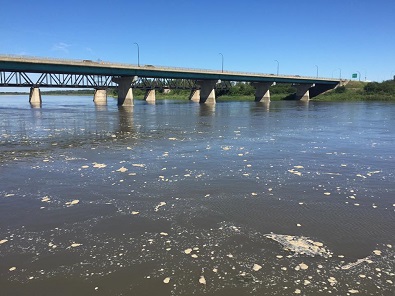Oil on the river at Prince Albert on July 26. Photo courtesy Estelle Hjertaas, Facebook.
The water in the North Saskatchewan River has been deemed safe to drink by Husky Energy, following the spill of more than 250,000 litres of heavy oil that was first detected on July 20.
However, there is still no indication when the communities affected can once again tap into the river for their water needs.
More than 1,000 samples have been taken, with 90 per cent of the results now in. Husky Energy issued a report based on these results on Wednesday morning, saying the sampling data was “collected by professional third party consultants as approved by Unified Command.”
So far, the results show only five samples do not meet Canadian water guidelines standards. Those five samples were taken within a 20 kilometre stretch of the river near the site of where the spill happened near Maidstone, three days after the spill. Re-tests have shown those samples are now safe as well.
One of the scientists doing the sampling, Paul Noney, said while the water meets Canadian standards that does not mean there are no traces of hydrocarbons in it.
“We are finding the compounds at very, very low concentrations,” he said. “The analytical capabilities of the laboratories that are analyzing these samples are very good. So we can detect that at very low concentrations that are insignificant from a public health stand point.”
According to the Husky report, the spilled oil is mainly “on the river shoreline, in the river water column, and in river sediment mostly at locations within 20 km downstream of the spill.”
The oil sheen and foams have been reported farther downstream – that’s something Prince Albert residents are familiar with, as both were highly visible in the days following the spill.
A map provided in the Husky Energy report, issued on Wednesday.
Sampling done at the water intakes for North Battleford and Prince Albert shows the water is well within the acceptable range.
While the lab test results are positive, they are not good enough for the Water Security Agency. Spokesman Patrick Boyle says a risk assessment needs to be done before a decision is made on whether to reopen the water intakes.
“For us, we need to be absolutely clear and comfortable with turning on the intakes and going through that process,” he said.
“It’s not something we can take lightly because, frankly, the risk is just too great.”
North Battleford, Prince Albert and Melfort all shut down their water intakes from the river and scrambled to find other sources until they get the all clear.
Prince Albert even constructed a $1 million, 30 kilometre above-ground hose pipeline so it could source the South Saskatchewan River.
Traces of the oil have been found more than 500 kilometres away at Codette Lake near Nipawin.
More tests are continuing and the Water Security Agency will release its own findings in coming days.

